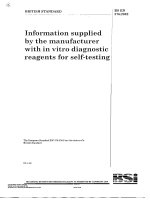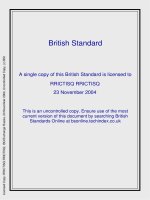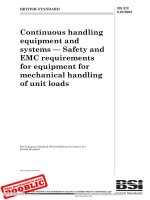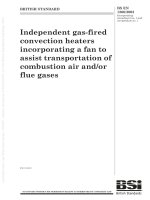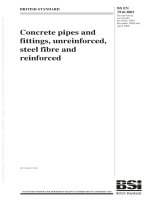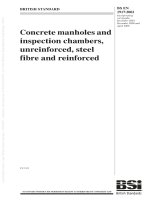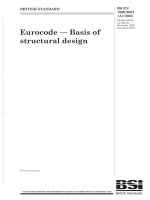Bsi bs en 00423 2002
Bạn đang xem bản rút gọn của tài liệu. Xem và tải ngay bản đầy đủ của tài liệu tại đây (98.13 KB, 8 trang )
BRITISH STANDARD
Resilient floor
coverings —
Determination of
resistance to staining
The European Standard EN 423:2001 has the status of a
British Standard
ICS 97.150
NO COPYING WITHOUT BSI PERMISSION EXCEPT AS PERMITTED BY COPYRIGHT LAW
BS EN
423:2002
BS EN 423:2002
National foreword
This British Standard is the official English language version of EN 423:2001.
It supersedes BS EN 423:1993 which is withdrawn.
The UK participation in its preparation was entrusted to Technical Committee
PRI/60, Resilient floor coverings, which has the responsibility to:
—
aid enquirers to understand the text;
—
present to the responsible European committee any enquiries on the
interpretation, or proposals for change, and keep the UK interests
informed;
—
monitor related international and European developments and
promulgate them in the UK.
A list of organizations represented on this committee can be obtained on
request to its secretary.
Cross-references
The British Standards which implement international or European
publications referred to in this document may be found in the BSI Standards
Catalogue under the section entitled “International Standards Correspondence
Index”, or by using the “Find” facility of the BSI Standards Electronic
Catalogue.
A British Standard does not purport to include all the necessary provisions of
a contract. Users of British Standards are responsible for their correct
application.
Compliance with a British Standard does not of itself confer immunity
from legal obligations.
This British Standard, having
been prepared under the
direction of the Sector Policy
and Strategy Committee for
Materials and Chemicals, was
published under the authority
of the Standards Policy and
Strategy Committee on
25 February 2002
Summary of pages
This document comprises a front cover, an inside front cover, the EN title page,
pages 2 to 5 and a back cover.
The BSI copyright date displayed in this document indicates when the
document was last issued.
Amendments issued since publication
Amd. No.
© BSI 25 February 2002
ISBN 0 580 39123 X
Date
Comments
EUROPEAN STANDARD
EN 423
NORME EUROPÉENNE
EUROPÄISCHE NORM
December 2001
ICS 97.150
Supersedes EN 423:1993
English version
Resilient floor coverings - Determination of resistance to staining
Revêtements de sol résilients - Détermination de résistance
aux taches
Elastische Bodenbeläge - Bestimmung der
Fleckenempfindlichkeit
This European Standard was approved by CEN on 18 November 2001.
CEN members are bound to comply with the CEN/CENELEC Internal Regulations which stipulate the conditions for giving this European
Standard the status of a national standard without any alteration. Up-to-date lists and bibliographical references concerning such national
standards may be obtained on application to the Management Centre or to any CEN member.
This European Standard exists in three official versions (English, French, German). A version in any other language made by translation
under the responsibility of a CEN member into its own language and notified to the Management Centre has the same status as the official
versions.
CEN members are the national standards bodies of Austria, Belgium, Czech Republic, Denmark, Finland, France, Germany, Greece,
Iceland, Ireland, Italy, Luxembourg, Netherlands, Norway, Portugal, Spain, Sweden, Switzerland and United Kingdom.
EUROPEAN COMMITTEE FOR STANDARDIZATION
COMITÉ EUROPÉEN DE NORMALISATION
EUROPÄISCHES KOMITEE FÜR NORMUNG
Management Centre: rue de Stassart, 36
© 2001 CEN
All rights of exploitation in any form and by any means reserved
worldwide for CEN national Members.
B-1050 Brussels
Ref. No. EN 423:2001 E
EN 423:2001 (E)
Foreword
This European Standard has been prepared by Technical Committee CEN/TC 134 "Resilient and textile floor
coverings", the secretariat of which is held by BSI.
This European Standard shall be given the status of a national standard, either by publication of an identical text or
by endorsement, at the latest by June 2002, and conflicting national standards shall be withdrawn at the latest by
June 2002.
This European Standard supersedes EN 423:1993.
According to the CEN/CENELEC Internal Regulations, the national standards organizations of the following
countries are bound to implement this European Standard: Austria, Belgium, Czech Republic, Denmark, Finland,
France, Germany, Greece, Iceland, Ireland, Italy, Luxembourg, Netherlands, Norway, Portugal, Spain, Sweden,
Switzerland and the United Kingdom.
2
EN 423:2001 (E)
1
Scope
This European Standard specifies a method for determining the resistance of a resilient floor covering to those
chemical substances it is likely to experience in service.
2
Principle
Various chemical substances in liquid or paste form are placed on a test piece for defined periods and removed.
After cleaning has been carried out the resulting change of appearance is assessed under specified lighting
conditions.
3
Apparatus and materials
3.1
Standard laboratory equipment
a)
pipettes;
b)
spatulas.
2
3.2 Untreated glass fibre fabric, of mass per unit area (300 to 400) g/m and diameter approximately
40 mm.
www.bzfxw.com
3.3
Chemical substances in liquid or paste form, to be agreed between the interested parties.
3.4
Standard cleaning and stain removal products.
3.4.1
White cotton, in pad or cloth form.
3.4.2
Brushes, hard, unlikely to score the surface.
3.4.3
Warm water, used alone or with the following:
a) synthetic detergent, e.g. sodium alkylsulfate;
b) soap;
c) alkaline products, e.g. washing soda or ammonia solution;
d) hydrogen peroxide;
e) sodium hypochlorite;
f)
sodium thiosulfate, 1 % solution;
g) oxalic acid.
3
EN 423:2001 (E)
3.4.4
Denatured ethanol
3.4.5
White spirit
3.4.6
Turpentine
3.5
Abrasives
Abrasive scouring pads, steel wool No. 00 or scouring powder, or abrasive papers, grain size P 240 or finer, used
with water.
3.6
Special cleaning products, special products, recommended by the floor covering manufacturer.
3.7 Illumination device, comprising a lamp of correlated colour temperature 5 500 K to 6 500 K, mounted to
give an intensity of light at the viewing platform of (1500 ± 100) lx and in such a way as to illuminate the test piece
vertically from above. The surroundings shall be neutral and darkened.
The intensity of the light shall be checked frequently by the use of a luxometer. The lifetime of the lamp, as given by
the manufacturer, shall not be exceeded.
3.8 Rotary viewing table, enabling the test piece to be rotated so that it may be viewed from all directions
under the standard illumination.
4
Sampling and preparation of test pieces
www.bzfxw.com
Take a representative sample from the available material.
2
Take one test piece in the colour(s) to be used with a surface area of at least 3 000 mm for each stain to be
tested. If the test uses a substance likely to cause swelling or deformation of the test piece, e.g. prolonged contact
with a solvent, bond the test piece to a fibre-cement sheet at least five days before testing.
Subject the test piece to any treatment required, e.g. light abrasion to remove surface polish or application of a
non-specified maintenance product.
Identify the positions corresponding to each of the substances used, either by marking numbers on the test piece
(using a marking which is not affected by the material used in the test), or by a sketch, diagram or photograph.
5
5.1
Procedure
Application of liquid substances
Place the fabric (3.2) on the surface of the test specimen and saturate it with 1 ml to 2 ml of the test liquid. Leave
the fabric in place for the duration of the test.
5.2
Application of paste substances
3
2
2
With a spatula, spread about 1 000 mm over an area of 300 mm to 400 mm , (i.e. thickness 2,5 mm to 3 mm).
5.3
Duration of contact
The main duration of contact shall be 2 h. If a stain appears on the test piece after 2 h, a new test shall be
conducted for a period of 30 min.
4
EN 423:2001 (E)
5.4
Types of cleaning and observation
5.4.1 Before cleaning, remove stains that are still liquid with cotton, working from the edge towards the centre of
the stain. Scrape off the remains of paste with a spatula and wipe with cotton as above.
After cleaning has been carried out, examine the residual staining from a distance of approximately 800 mm at an
o
approximate angle of 45 and from all directions by slowly rotating the viewing table.
5.4.2 If a stain is visible, rub it down with a mild abrasive material or a cleaning product recommended by the
manufacturer, and examine as described in 5.4.1.
NOTE
6
If white spirit or turpentine are used, these should be rinsed off with denatured ethanol.
Expression of results
Express the results in accordance with Table 1.
Table 1 — Interpretation and presentation of results
Index
Effect of the test after
cleaning/abrasion
0
Not affected
1
Very slightly affected
2
3
www.bzfxw.com
4
7
Slightly affected
Affected
Severely affected
Test report
The test report shall contain the following information:
a) a reference to this standard, i.e. EN 423;
b) a complete identification of the product tested, including type, source, colour and manufacturer’s reference
numbers;
c) previous history of the sample;
d) the staining materials, type of cleaning and contact periods used;
e) the test results in accordance with Table 1;
f)
any deviation from this standard which may have affected the results.
5
BS EN
423:2002
BSI — British Standards Institution
BSI is the independent national body responsible for preparing
British Standards. It presents the UK view on standards in Europe and at the
international level. It is incorporated by Royal Charter.
Revisions
British Standards are updated by amendment or revision. Users of
British Standards should make sure that they possess the latest amendments or
editions.
It is the constant aim of BSI to improve the quality of our products and services.
We would be grateful if anyone finding an inaccuracy or ambiguity while using
this British Standard would inform the Secretary of the technical committee
responsible, the identity of which can be found on the inside front cover.
Tel: +44 (0)20 8996 9000. Fax: +44 (0)20 8996 7400.
BSI offers members an individual updating service called PLUS which ensures
that subscribers automatically receive the latest editions of standards.
Buying standards
Orders for all BSI, international and foreign standards publications should be
addressed to Customer Services. Tel: +44 (0)20 8996 9001.
Fax: +44 (0)20 8996 7001. Email: Standards are also
available from the BSI website at .
In response to orders for international standards, it is BSI policy to supply the
BSI implementation of those that have been published as British Standards,
unless otherwise requested.
Information on standards
www.bzfxw.com
BSI provides a wide range of information on national, European and
international standards through its Library and its Technical Help to Exporters
Service. Various BSI electronic information services are also available which give
details on all its products and services. Contact the Information Centre.
Tel: +44 (0)20 8996 7111. Fax: +44 (0)20 8996 7048. Email:
Subscribing members of BSI are kept up to date with standards developments
and receive substantial discounts on the purchase price of standards. For details
of these and other benefits contact Membership Administration.
Tel: +44 (0)20 8996 7002. Fax: +44 (0)20 8996 7001.
Email:
Information regarding online access to British Standards via British Standards
Online can be found at />Further information about BSI is available on the BSI website at
.
Copyright
Copyright subsists in all BSI publications. BSI also holds the copyright, in the
UK, of the publications of the international standardization bodies. Except as
permitted under the Copyright, Designs and Patents Act 1988 no extract may be
reproduced, stored in a retrieval system or transmitted in any form or by any
means – electronic, photocopying, recording or otherwise – without prior written
permission from BSI.
BSI
389 Chiswick High Road
London
W4 4AL
This does not preclude the free use, in the course of implementing the standard,
of necessary details such as symbols, and size, type or grade designations. If these
details are to be used for any other purpose than implementation then the prior
written permission of BSI must be obtained.
Details and advice can be obtained from the Copyright & Licensing Manager.
Tel: +44 (0)20 8996 7070. Fax: +44 (0)20 8996 7553.
Email:

